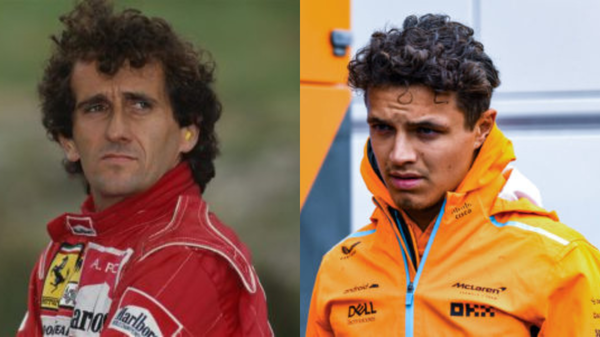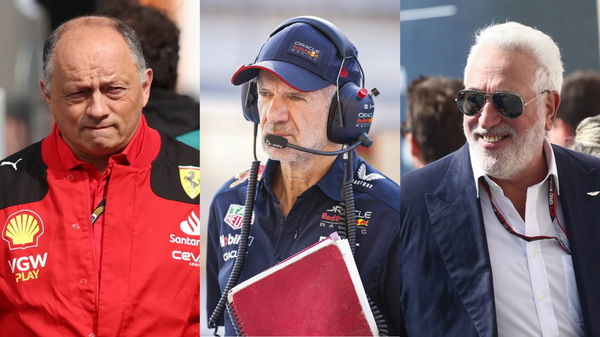Lando Norris Shares Heart Sinking Experience as Alain Prost’s Legendary Beast Threw Unexpected Challenge

Follow Us

via Imago
Alain Prost (L, Lando Norris (R), Via Imago
When Niki Lauda won his final World title with the McLaren MP4/2 in 1984, little did he know that the car he was leaving behind would bring about one of McLaren’s best periods in Formula 1. The Woking-outfit finally caved into turbocharging their challenger after years of sticking to a naturally aspirated setup.
Lando Norris got to experience just why the MP4/2 was so scary to drive, though Lauda and Alain Prost managed to win 12 out of the 16 races in 1984, and the innovations brought about by its design still linger in the blueprint of modern-day F1 cars. Whilst Charles Leclerc’s outing with a retro Ferrari ended in heartbreak, Norris kept the McLaren beast at bay despite the adrenaline rush!
Lando Norris puts himself in Alain Prost’s seat
ADVERTISEMENT
Article continues below this ad
During the Velocity Invitational at Sonoma International Raceway, Lando Norris joined McLaren motorsport drivers Pato O’Ward and Tony Kanaan to demonstrate the Woking outfit’s most iconic cars throughout its history in motor racing.
Lando catching up with Pato and Tony after driving🫶🫶 pic.twitter.com/RhBbQlcIht
— Lando Norris Fans (@Norrislandofans) November 12, 2023
Whilst the McLaren Arrows Indycar driver, Pato O’Ward drove Bruce McLaren’s 1969 M7C, and fellow Indycar icon, Tony Kanaan got to drive the legendary Ayrton Senna’a MP4/6 during the invitational. With all three drivers taking a trip back to the past to master the older machinery for a few laps, the struggles were paramount for the three.
Trending

Lando Norris Faces Brutal Injury After Party With Martin Garrix Goes Wrong Ahead of Miami GP
April 27, 2024 07:33 PM EDT

Liam Lawson’s Surprise Contract Clause Threatens Daniel Ricciardo’s RB Seat
April 24, 2024 11:15 AM EDT

Miami GP Organisers Threaten to Revoke Donald Trump’s $250,000 Proposition for the Miami International Autodrome
April 27, 2024 04:47 PM EDT

Adrian Newey’s “Personal Issue” With Christian Horner the Reason Behind Red Bull Mastermind’s Exit
April 27, 2024 10:51 AM EDT

F1 Rumor: Lawrence Stroll Offers Adrian Newey $100 Million to Poach Him From Frederic Vasseur and Co’s Interest
April 26, 2024 03:16 PM EDT
Get instantly notified of the hottest F1 stories via Google! Click on Follow Us and Tap the Blue Star.

Follow Us
In a video shared on Twitter, the trio can be seen exchanging their opinions when Tony Kanaan asked Norris, “What did you drive?” which prompted the 23-year-old to share the struggles he faced with McLaren’s first turbocharged challenger, “The Prost (MP4/2), bit of lag on the old turbo, the first few laps were like woah, my heel and toe I was like blip and then clutch but like yeah just had to slam the gas.” –being a turbocharged car back in the older days, the turbo lag that the MP4/2 produced was significantly higher than on modern cars, which meant Norris was in for quite a shock when he stepped his foot down and got a kick after a short delay.

“That’s How Old He Is”: Lando Norris Ruthlessly Mocks Lewis Hamilton Only to Reveal Sincere Respect Moments Later
Whilst the three drivers drove some of the most well-recognized McLaren challengers, their lines during the laps were a great indicator of just how feisty these cars can be. Whilst our modern racers feel much more comfortable with their technological marvels today, the MP4/2 laid the very foundation for Lando Norris to even be here today, after all, it marked the beginning of McLaren’s glory days. But just what was so special about the car?
Why was the MP4/2 so revolutionary?
The first rendition of the MP4/2, the car Lando Norris drove at the Velocity Invitational, laid down the framework for how modern-day Formula 1 cars look, and in many ways was a key factor in getting McLaren to where they are today. While the car was not great at one-lap pace, it excelled in the races. With only three pole positions, the MP4/2 still managed to give the Woking outfit 12 wins that season, with Prost leading Lauda by two wins.
The MP4/2 was a rework of John Barnard’s masterpiece – MP4/1, but what made this car so much more special was its engine. Which was developed by Porsche after Barnard convinced Bruce McLaren that the Woking outfit needed to create a bespoke engine to fit into the carefully crafted engine bay which would maximize the ground effect. This along with the revolutionary Carbon fibre composite chassis and brakes, made the MP4/2 a blueprint for perfection in the 80’s.
ADVERTISEMENT
Article continues below this ad
The engine had a few tricks up its sleeve to pounce on the competition, with a notable feature being the sequential injection system which eliminated the need for the engine to complete a whole revolution before air: fuel ratios could be tinkered with, allowing the car to maximize its power delivery whilst maintaining incredibly fuel efficiency. This meant that the MP4/2 produced over 800hp throughout the entire Grand Prix, allowing Niki Lauda to win his last world title with honors.
But that’s not the only contribution of the MP4/2 to the world of F1 engineering, it also introduced the Coke bottle idea which we see on cars to this day! Created by Alan Jenkins under Barnard’s lead, the MP4/2 featured side pods that would converge toward the rear wheels, sending high-pressure airflow for enhanced aerodynamics.
ADVERTISEMENT
Article continues below this ad
WATCH THIS STORY | Is McLaren Looking To Go With Red Bull on its Engine Round About?
It’s safe to say the contributions that the MP4/2 and John Barnard made towards driving innovation in the sport have paved the way for modern Formula 1 cars and their god-like performance, even if Lando Norris won’t take it for another spin!
Edited by:

Aishwary Gaonkar
